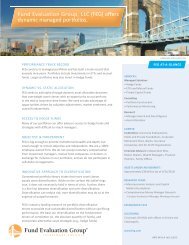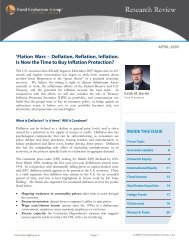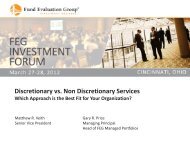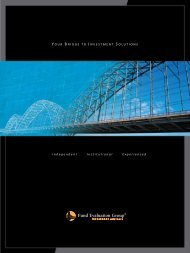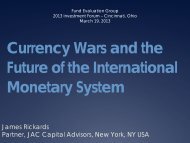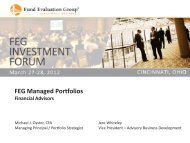download pdf - Fund Evaluation Group, LLC
download pdf - Fund Evaluation Group, LLC
download pdf - Fund Evaluation Group, LLC
Create successful ePaper yourself
Turn your PDF publications into a flip-book with our unique Google optimized e-Paper software.
focus on experienced and stable fund management teams, with some<br />
form of a pan-emerging-markets focus, to ensure a healthy perspective<br />
on valuations.<br />
Within the U.S., interesting trends are emerging. Credit markets are<br />
sifting from conservative to aggressive, which is likely to increase<br />
merger & acquisition activity and benefit buyout funds, provided they<br />
avoid “too much of a good thing.” <strong>Fund</strong>amentally, manufacturing in<br />
the U.S. is increasingly competitive with overseas markets. Several<br />
factors are driving this trend: cheap and abundant energy as compared<br />
to other developed markets, rising labor and land costs in Asia, and<br />
innovation in advanced technologies. These factors are highlighted in<br />
the sidebar on this page.<br />
Secondary markets continued to enjoy a robust pipeline of<br />
opportunity. The double-strength volume is attributable to heavy<br />
selling by financial institutions, primarily for regulatory reasons,<br />
alongside the maturity of peak fundraising vintage year funds (those<br />
formed between 2005 and 2007). Pricing remains moderate, which<br />
positions recent vintage year secondary funds in line for robust returns.<br />
Private Debt Outlook<br />
Credit markets rallied significantly in 2012 and rewarded investors<br />
across strategies and geographies. Securitized assets, including<br />
residential mortgage-backed securities (RMBS) and commercial<br />
mortgage-backed securities (CMBS), posted double-digit returns. Some<br />
RMBS recorded price movements of 50% or better for the year. 11 At<br />
this point in the cycle, the major move is behind us, but the assets<br />
continue to offer attractive returns when compared with other credit<br />
opportunities.<br />
Relative to expectations for 2012, European debt provided healthy<br />
opportunities, but not the flood of activity expected. Increased capital<br />
requirements for European banks, defined in the Basel III regulations,<br />
were postponed. At present, most banks have the capacity to sell and<br />
many have active selling programs. Globally, PwC estimates $80 billion<br />
of illiquid asset sales will occur in 2013, up from $58 billion in 2012. 12<br />
Distressed credits trading in the current environment are more<br />
idiosyncratic than earlier in the cycle. Value is likely to be realized over<br />
time, not from a quick trade.<br />
Issuance of new debt in conjunction with buyout deals and<br />
recapitalizations ramped up late in the year. Recapitalizations alone<br />
generated over $64 billion in dividends to investors. 13 Activity may<br />
have been influenced by a desire to move ahead of tax law changes in<br />
the U.S. Many new deals featured “covenant lite” and PIK (pay in<br />
kind) options, reminiscent of the credit bubble days. Conditions today<br />
have been described as “short of frothy” but they are trending that<br />
Page 3<br />
FOURTH QUARTER 2012<br />
ADVANTAGE U.S.?<br />
THREE REASONS TO FAVOR<br />
MANUFACTURING AT HOME:<br />
Cheap Energy:<br />
and<br />
Labor and Land:<br />
Technology and Speed:<br />
© 2013 <strong>Fund</strong> <strong>Evaluation</strong> <strong>Group</strong>, <strong>LLC</strong>




